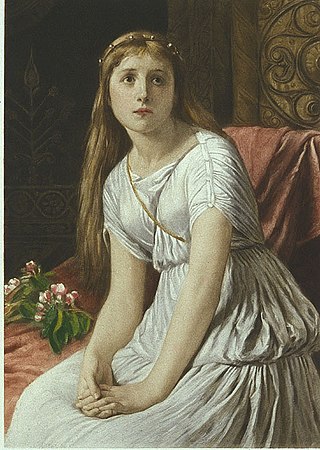Related Research Articles

Locrinus was a legendary king of the Britons, as recounted by the 12th-century chronicler Geoffrey of Monmouth in his Historia Regum Britanniae. He came to power in 1125BC.
Gwendolen, also known as Gwendolin, or Gwendolyn was a legendary ruler of ancient Britain. She came to power in 1115BC.
Maddan was a legendary king of the Britons as accounted by Geoffrey of Monmouth. He came to power in 1100BC. He was the son of King Locrinus and Queen Gwendolen, who both ruled Britain separately.
Mempricius was a legendary king of the Britons, as recounted by Geoffrey of Monmouth. He came to power in 1060BC. He was the son of King Maddan, brother of Malin, and father of king Ebraucus.

Leir was a legendary king of the Britons whose story was recounted by Geoffrey of Monmouth in his pseudohistorical 12th-century History of the Kings of Britain. According to Geoffrey's genealogy of the British dynasty, Leir reigned around the 8th century BC, around the time of the founding of Rome. The story was modified and retold by William Shakespeare in his Jacobean tragedy King Lear.

Cordelia was a legendary Queen of the Britons, as recounted by Geoffrey of Monmouth. She came to power in 855BC.
Cunedagius was a legendary king of the Britons, as recounted by Geoffrey of Monmouth. He came to power in 850BC.
Sisillius I was a legendary king of the Britons as accounted by Geoffrey of Monmouth. He came to power in 753 BC.
Kimarcus was a legendary king of the Britons according to Geoffrey of Monmouth. He was the son of Sisillius I. and was succeeded by Gorboduc. Geoffrey has nothing to say of him beyond this.
Gurguit Barbtruc was a legendary king of the Britons as accounted by Geoffrey of Monmouth. He was the son of Belinus and was said to have found a home for the Irish people.
Guithelin was a legendary king of the Britons as accounted by Geoffrey of Monmouth. He became king after the death of Gurguit Barbtruc and reigned approximately 379 BC.
Marcia was the legendary third female ruler and a regent of the Britons, as recounted by Geoffrey of Monmouth. She is presented by Geoffrey as "one of the most illustrious and praiseworthy of women in early British history".
Danius was a legendary king of the Britons as recounted by Geoffrey of Monmouth. He came to power in 361BC.
Enniaunus was a legendary king of the Britons as recounted by Geoffrey of Monmouth. He came to power in 293BC.
Catellus was a legendary king of the Britons, as recounted in Geoffrey of Monmouth's work Historia Regum Britanniae. He came to power in 269 BC.
Sisillius III was a legendary king of the Britons as accounted by Geoffrey of Monmouth. He reigned approximately 173–167 BC.
Beldgabred was a legendary king of the Britons as accounted by Geoffrey of Monmouth. He reigned approximately 167–161 BC.
Peredurus is a legendary king of the Britons in Geoffrey of Monmouth's pseudohistorical chronicle Historia Regum Britanniae. According to Geoffrey, he was the youngest son of King Morvidus and brother of Gorbonianus, Archgallo, Elidurus, and Ingenius. He came to power in 317 BC.

Jago was a legendary king of the Britons according to Geoffrey of Monmouth. He was the nephew of Gurgustius, succeeded his cousin Sisillius I to the throne and was succeeded by Sissillius' son Kimarcus. Geoffrey has nothing more to say of him.

Rowena in the Matter of Britain was the daughter of the purported Anglo-Saxon chief Hengist and wife of Vortigern, "King of the Britons". Presented as a beautiful femme fatale, she won her people the Kingdom of Kent through her treacherous seduction of Vortigern. Contemporary sources are nearly non-existent, so it is impossible to know if she actually existed.
References
- 1 2 3 Geoffrey of Monmouth. History of the Kings of Britain. p. 101.
- ↑ Monarchie Nobelesse website, Bretons